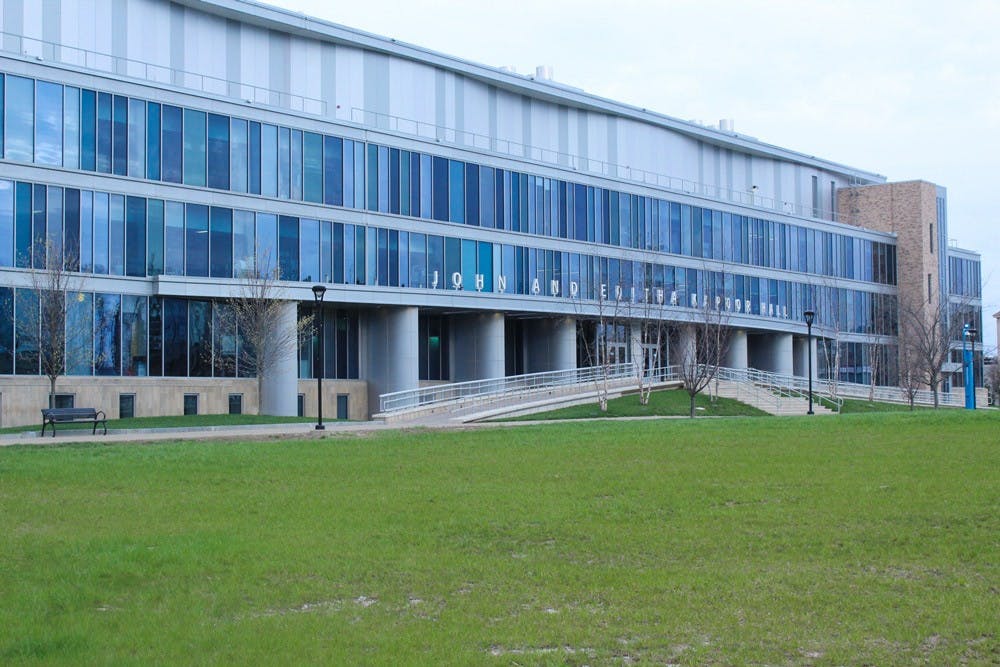When Kapoor Hall opened its doors in the fall of 2012, the light-filled, $62 million building marked a proud new chapter in the UB School of Pharmacy and Pharmaceutical Sciences.
The building was named on behalf of donor John Kapoor, who donated over $10.8 million to the school – currently ranked No. 22 in the nation, according to U.S. News & World Report – through the John and Editha Kapoor Charitable Foundation. But in the last few years, Kapoor’s company, Insys Therapeutics, has been less admirable than the stunning building that bears his name.
In December of last year, six Insys executives were charged with conspiring to bribe doctors to prescribe their mouth-spray version of Fentanyl – an opioid 80 times stronger than morphine, according to Forbes.
Kapoor’s name remains across the Pharmacy School’s main entrance, but Kapoor himself was not charged with any involvement in the alleged criminal activities.
Still, some in the UB community feel his involvement in contributing to the legal opioid problem, intentional or not, should warrant his name’s removal.
UB spokesperson John Della Contrada said the university is aware of the charges involving employees formerly associated with Insys Therapeutics.
“During a career spanning many years, Dr. Kapoor has played an important role in developing medical treatments that relieve the anguish of those who suffer from severe and chronic pain due to cancer and other debilitating diseases and he has developed pharmaceutical products in the areas of ophthalmology, antidotes and anti-infectives,” Della Contrada said in an email.
Della Contrada said the building bears the Kapoor name in recognition of the couple’s “long-time support” of the school.
Kapoor is a Ph.D of medicinal chemistry, pharmaceutical entrepreneur and recipient of UB’s Distinguished Alumni Award. Forbes estimated his net worth at $2.1 billion in 2016.
“Kapoor has run a number of pharmaceutical companies over his 40-year career, often allowing them to push ethical and legal limits, confident that he could clean up the mess afterward,” Forbes wrote in a 2015 profile on Kapoor.
“If you ask me, a donor with questionably amoral practices, to me that isn’t news. Lots of people with less than reputable character have their names on plenty of buildings,” said Elizabeth Mariani, a UB alumnus. “Look at the man leading our country. How many buildings is his name on?”
Mariani said she was initially angry when she heard the charges surrounding Kapoor. Her brother overdosed in 2015 after battling opioid addiction for years.
She said she understands why many feel upset and hurt by the allegations. But for Mariani, the opioid abuse epidemic goes beyond the walls of any building.
“I’m a proud UB alum, I think the school is in charge of its brand, the pharmacy school is in charge of its brand,” Mariani said.
In December 2016, six Insys executives were arrested and charged with conspiracy to bribe doctors and in the process, potentially hurt patients and defraud insurers. The indictments contained a pattern of allegations. For instance, in one charge, Insys allegedly paid a doctor $229,640 for speaking events called “sham events,” attended by friends or office staff. The same doctor then wrote 2,148 prescriptions for Subsys during this period.
Despite Kapoor’s financial ties to Subsys – Forbes estimated close to $60 million of his net worth is from Subsys shares – Kapoor himself has not been charged with anything.
But the question of a name on a building has been simmering within academia for decades now.
Last April, Princeton University announced it would keep President Woodrow Wilson’s name on a school building after groups on campus called for removing Wilson for his racist past.
Princeton’s board of trustees promised instead to expand on the school’s promise of equity, diversity and inclusion and to be more transparent “in recognizing Wilson’s failings and shortcomings as well as the visions and achievements that led to the naming of the school and the college in the first place,” according to The Washington Post.
In 2005, Seton Hall University changed the name of an academic building named for L. Dennis Kozlowski, after the donor and former Tyco CEO was charged for embezzlement. Kozlowski asked for his name to be removed to spare the school’s embarrassment, according to CNN Money.
Brandon Raleigh, a UB alumnus and resident at the Jacobs School of Medicine, first heard about Kapoor and Insys from a colleague and didn’t think much of it. More recently, Raleigh was searching for articles related to the opioid crisis; and everywhere he looked, he saw Insys.
“I felt disgusted and disappointed, but far from shocked,” Raleigh said. “In the future, there should be a higher level of scrutiny regarding sources of donations. The medical establishment needs to take a long, hard look at the influence of for-profit companies on medical education and healthcare at large.”
Sarah Crowley is the senior features editor and can be reached at sarah.crowley@ubspectrum.com





